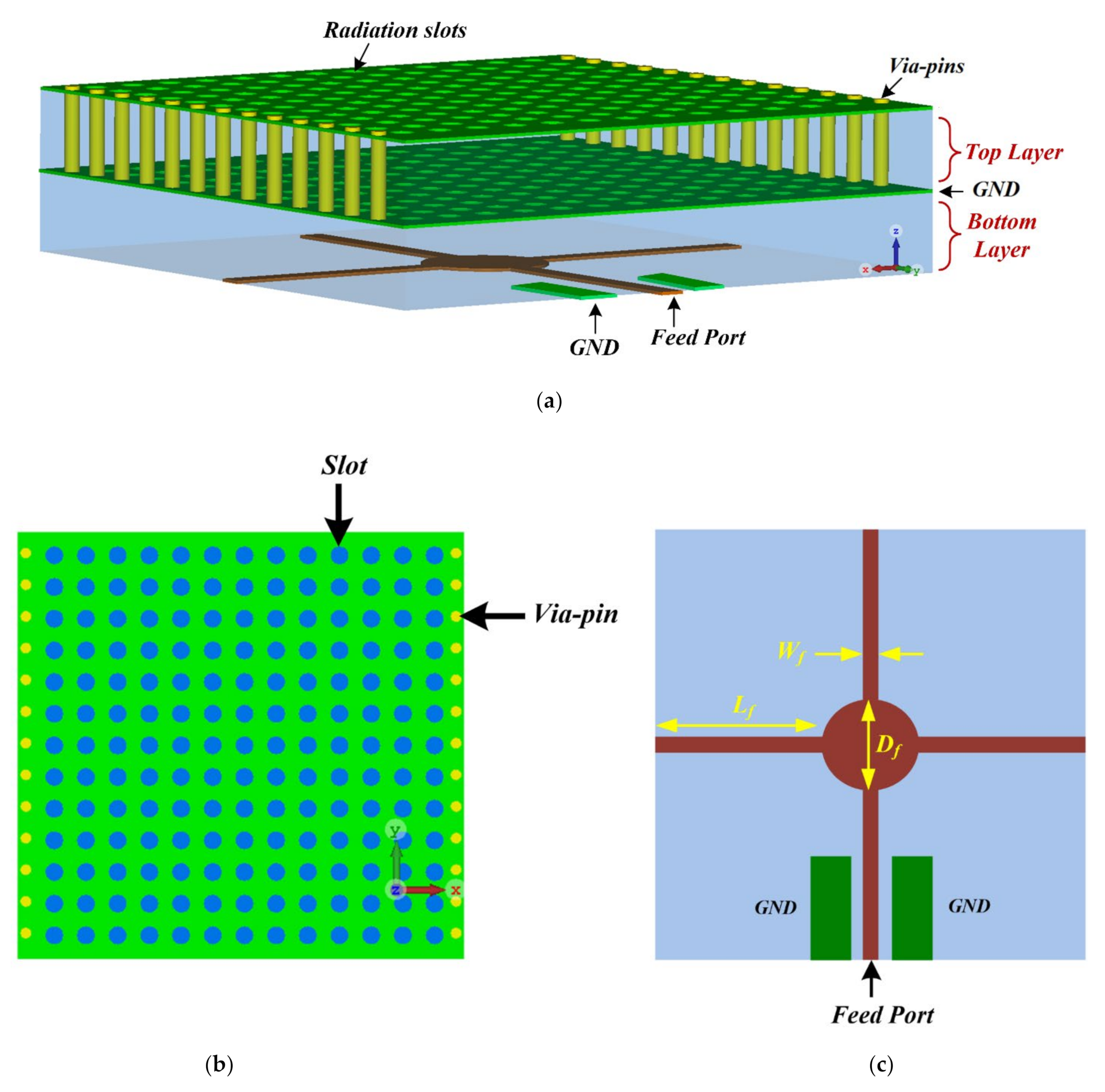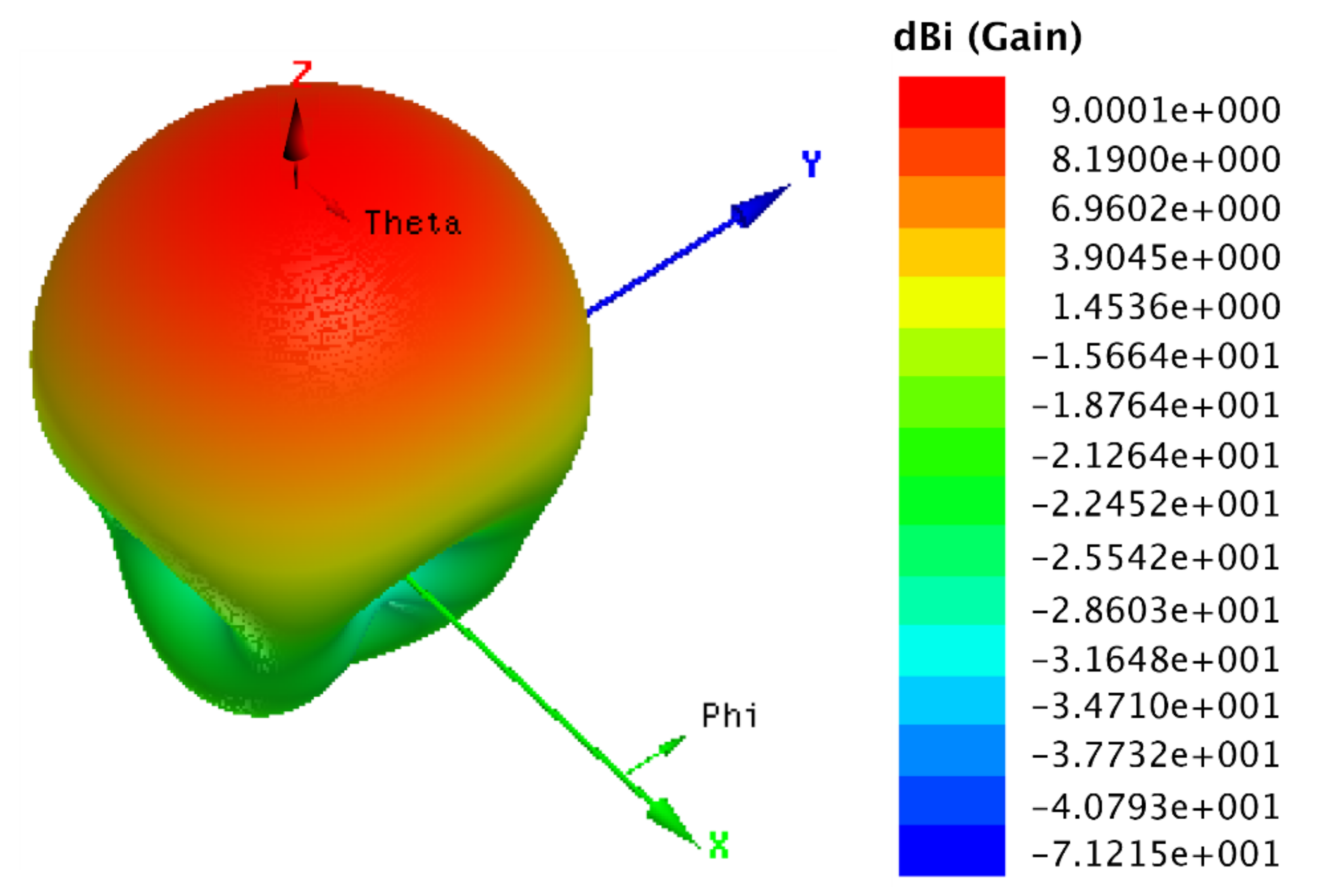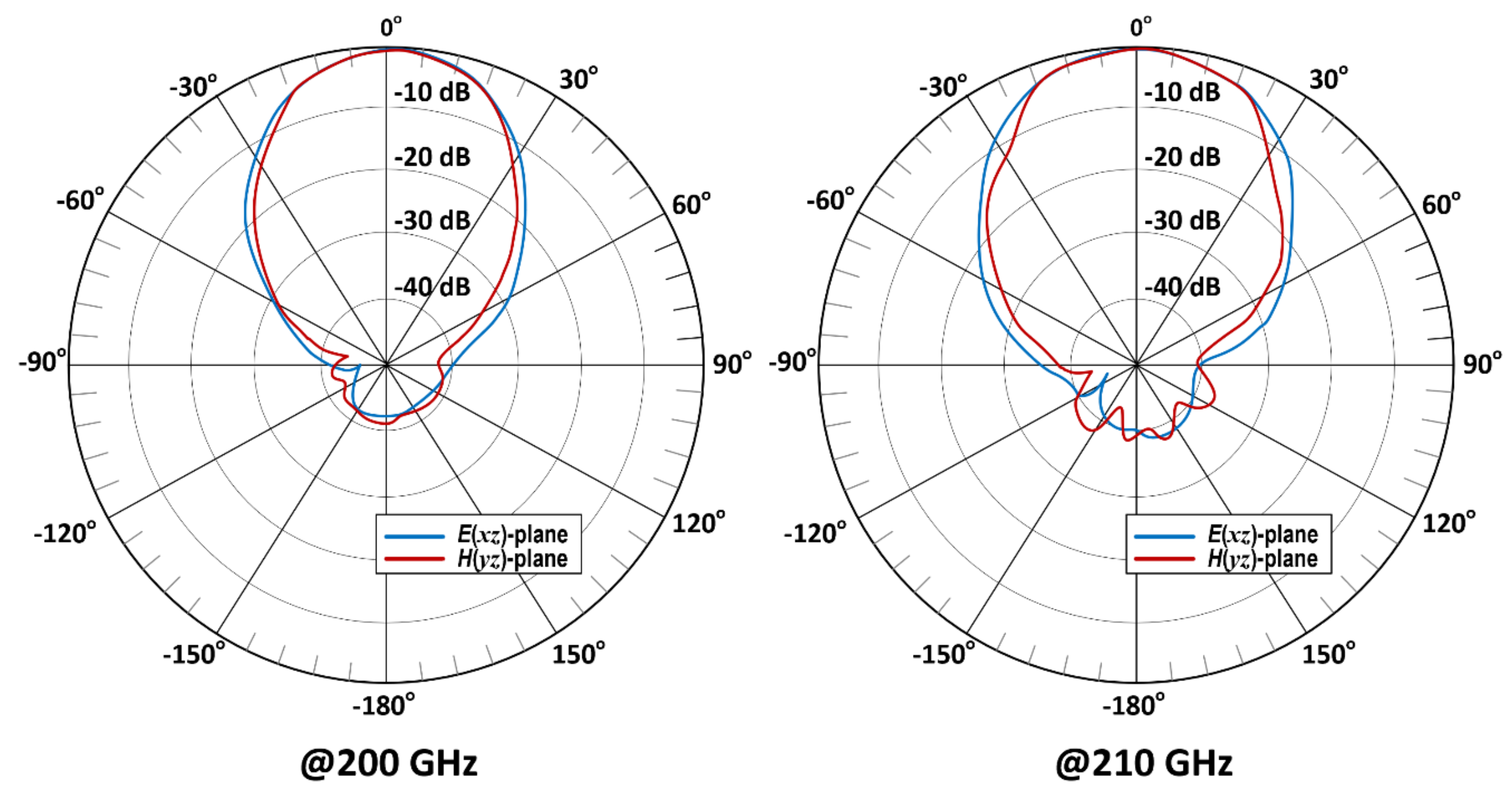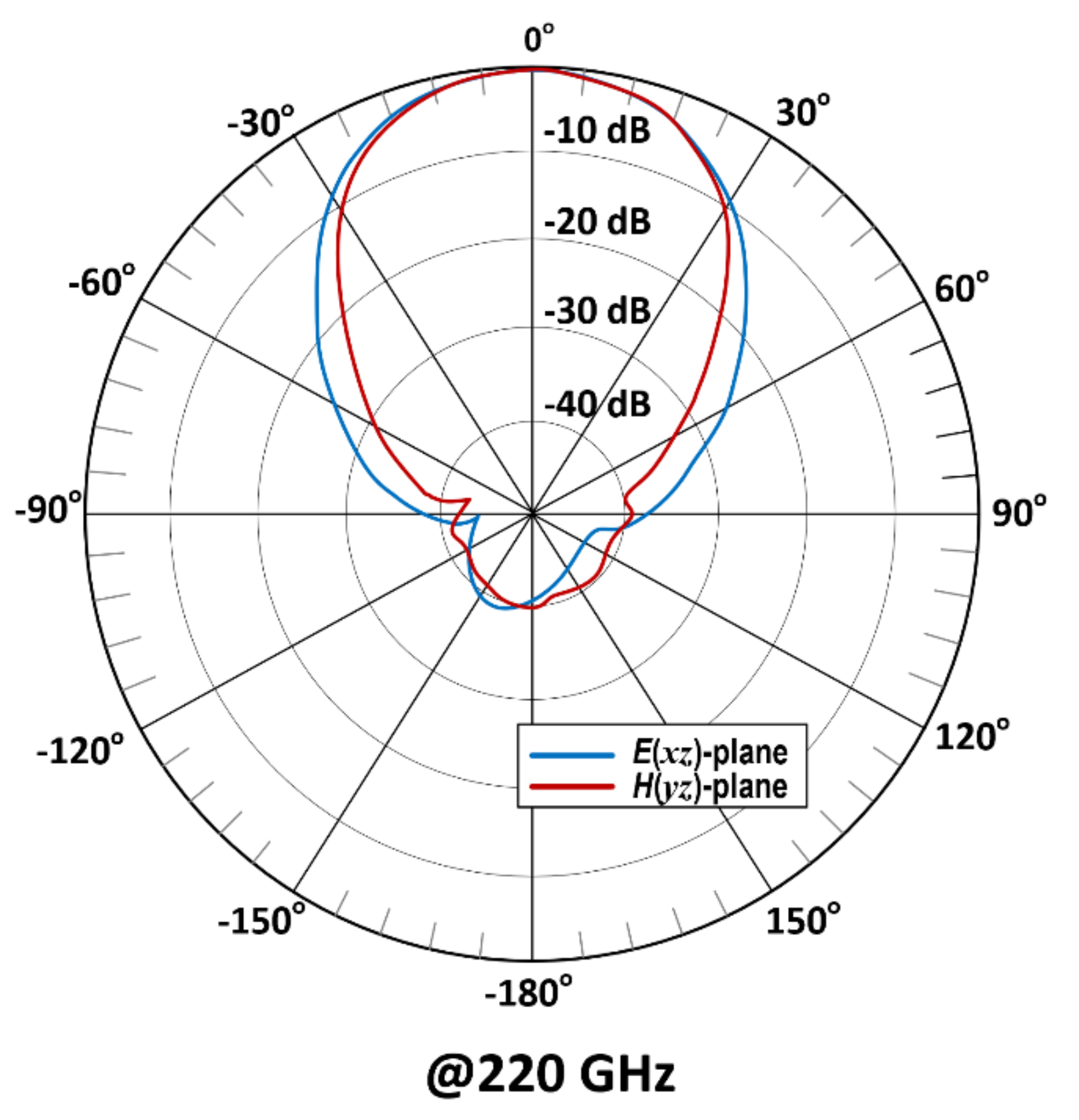Compact and Low-Profile On-Chip Antenna Using Underside Electromagnetic Coupling Mechanism for Terahertz Front-End Transceivers
Abstract
1. Introduction
2. High Performance Antenna On-Chip
3. Conclusions
Author Contributions
Funding
Data Availability Statement
Conflicts of Interest
References
- Woolard, D.L.; Brown, R.; Pepper, M.; Kemp, M. Terahertz Frequency Sensing and Imaging: A Time of Reckoning Future Applications? Proc. IEEE 2005, 93, 1722–1743. [Google Scholar] [CrossRef]
- Pawar, A.Y.; Sonawane, D.D.; Erande, K.B.; Derle, D.V. Terahertz Technology and its Applications. Drug Inven. Today 2013, 5, 157–163. [Google Scholar] [CrossRef]
- Alibakhshikenari, M.; Virdee, B.S.; Khalily, M.; See, C.H.; Abd-Alhameed, R.; Falcone, F.; Denidni, T.A.; Limiti, E. High-Gain On-Chip Antenna Design on Silicon Layer With Aperture Excitation for Terahertz Applications. IEEE Antennas Wirel. Propag. Lett. 2020, 19, 1576–1580. [Google Scholar] [CrossRef]
- Sankaran, S.; Mao, C.; Seok, E.; Shim, D.; Cao, C.; Han, R.; Arenas, D.J.; Tanner, D.B.; Hill, S.; Hung, C.-M.; et al. Towards Terahertz Operation of CMOS. In Proceedings of the 2009 IEEE International Solid-State Circuits Conference-Digest of Technical Papers, San Francisco, CA, USA, 8–12 February 2009; pp. 202–203. [Google Scholar] [CrossRef]
- Cavallo, D.; Syed, W.H.; Neto, A. Efficiency and Bandwidth Enhancement of on-Chip Antennas by Using Connected Arrays and Artificial Dielectrics. In Proceedings of the 2016 41st International Conference on Infrared, Millimeter, and Terahertz waves (IRMMW-THz), Copenhagen, Denmark, 25–30 September 2016; pp. 1–2. [Google Scholar]
- Syed, W.H.; Fiorentino, G.; Cavallo, D.; Spirito, M.; Sarro, P.M.; Neto, A. Design, Fabrication, and Measurements of a 0.3 THz On-Chip Double Slot Antenna Enhanced by Artificial Dielectrics. IEEE Trans. Terahertz Sci. Technol. 2015, 5, 288–298. [Google Scholar] [CrossRef]
- Zhu, H.; Li, N.; Zeng, J.; Li, X.; Ai, B. A Novel 0.22-THz On-Chip Antenna Based AMCs. In Proceedings of the Asia-Pacific Microwave Conference, Sendai, Japan, 4–7 November 2014; pp. 366–368. [Google Scholar]
- Abdellatif, A.S.; Taeb, A.; Safavi-Naeini, S.; Schmalz, K. A Terahertz High-Efficiency On-Chip Antenna. In Proceedings of the 2014 IEEE Antennas and Propagation Society International Symposium (APSURSI), Memphis, TN, USA, 6–11 July 2014; pp. 1485–1486. [Google Scholar]
- Caloz, C.; Itoh, T. Electromagnetic Metamaterials: Transmission Line Theory and Microwave Applications; John Wiley & Sons, Inc.: New York, NY, USA, 2005; Volume 7, pp. 316–322. [Google Scholar] [CrossRef]
- Alibakhshikenari, M.; Virdee, B.S.; Ali, A.; Limiti, E. Extended Aperture Miniature Antenna Based on CRLH Metamaterials for Wireless Communication Systems Operating Over UHF to C-Band. Radio Sci. 2018, 53, 154–165. [Google Scholar] [CrossRef]
- Wu, K.; Cheng, Y.J.; Djerafi, T.; Hong, W. Substrate-Integrated Millimeter-Wave and Terahertz Antenna Technology. Proc. IEEE 2012, 100, 2219–2232. [Google Scholar] [CrossRef]
- Bozzi, M.; Pasian, M.; Perregrini, L.; Wu, K. On the Losses in Substrate-Integrated Waveguides and Cavities. Int. J. Microw. Wirel. Technol. 2009, 1, 395–401. [Google Scholar] [CrossRef]
- Jiang, Z.H.; Yun, S.; Lin, L.; Bossard, J.A.; Werner, D.H.; Mayer, T.S. Tailoring Dispersion for Broadband Low-loss Optical Metamaterials Using Deep-Subwavelength INCLUSIONS. Sci. Rep. 2013, 3, 1571. [Google Scholar] [CrossRef] [PubMed]





| Parameter | Dimensions |
|---|---|
| Thickness of silicon layers | 125 μm |
| Thickness of metal layers | 5 μm |
| Radius of slots | 20 μm |
| Gap between slots | 30 μm |
| Radius of via-pins | 12 μm |
| Height of via-pins | 135 μm |
| Gap between via-pins | 46 μm |
| Lf (see Figure 1) | 400 μm |
| Wf (see Figure 1) | 40 μm |
| Df (see Figure 1) | 200 μm |
| Surface area of AoC | 1000 × 1000 μm2 |
| GND plane | 1000 × 1000 μm2 |
Publisher’s Note: MDPI stays neutral with regard to jurisdictional claims in published maps and institutional affiliations. |
© 2021 by the authors. Licensee MDPI, Basel, Switzerland. This article is an open access article distributed under the terms and conditions of the Creative Commons Attribution (CC BY) license (https://creativecommons.org/licenses/by/4.0/).
Share and Cite
Alibakhshikenari, M.; Virdee, B.S.; Althuwayb, A.A.; Mariyanayagam, D.; Limiti, E. Compact and Low-Profile On-Chip Antenna Using Underside Electromagnetic Coupling Mechanism for Terahertz Front-End Transceivers. Electronics 2021, 10, 1264. https://doi.org/10.3390/electronics10111264
Alibakhshikenari M, Virdee BS, Althuwayb AA, Mariyanayagam D, Limiti E. Compact and Low-Profile On-Chip Antenna Using Underside Electromagnetic Coupling Mechanism for Terahertz Front-End Transceivers. Electronics. 2021; 10(11):1264. https://doi.org/10.3390/electronics10111264
Chicago/Turabian StyleAlibakhshikenari, Mohammad, Bal S. Virdee, Ayman A. Althuwayb, Dion Mariyanayagam, and Ernesto Limiti. 2021. "Compact and Low-Profile On-Chip Antenna Using Underside Electromagnetic Coupling Mechanism for Terahertz Front-End Transceivers" Electronics 10, no. 11: 1264. https://doi.org/10.3390/electronics10111264
APA StyleAlibakhshikenari, M., Virdee, B. S., Althuwayb, A. A., Mariyanayagam, D., & Limiti, E. (2021). Compact and Low-Profile On-Chip Antenna Using Underside Electromagnetic Coupling Mechanism for Terahertz Front-End Transceivers. Electronics, 10(11), 1264. https://doi.org/10.3390/electronics10111264










